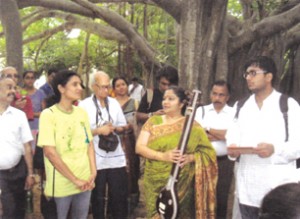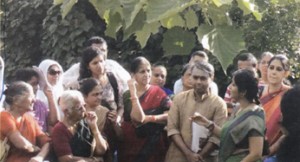Registered with the Registrar of Newspapers for India under R.N.I 53640/91
Vol. XXV No. 12, October 1-15, 2015
Singing for the trees
Nizhal, a Chennai-based NGO, which works towards nurturing and promoting sensitive urban greening, recently blazed a trail by linking the worlds of trees, literature and Carnatic music during its Madras Week celebrations.
The first of these Musical Tree Walks was conducted in the sylvan campus of Kalakshetra at Tiruvanmiyur, Chennai. Led by Nizhal team members who spoke about some important trees in the campus, each of these expositions was musically embellished by Dr. S. Sowmya and her team, who described the songs in which the trees find mention.

Sowmya and her team
An evergreen tree with a thick canopy and star-shaped, tiny but fragrant flowers, Magizham is called Vakula or Simhamukhi in Sanskrit. Vakula flowers used for worship are mentioned in the Tyagaraja kriti Sree Tulasamma. The raga Vakulabharanam gets its name from this flower.
A less known fact is that Vakulabharanam was one of the several epithets of Nammazhwar. Incidentally, this tree is the sthala vriksha of the Tiruvottriyur temple.
The mango tree is much loved for its fruit. Its leaves, which have antibacterial properties, are used as toranams during festivals. Its many Sanskrit names are Amra, Maakanda and Chuta. The mango finds mention in Muthuswami Dikshitar’s Bhairavi raga kriti Chintaya makanda-mula-kandam and in the Tiruppugazh Paadi-mati-nadi.
A tree with thick, glossy leaves and fragrant white flowers, the Punnai is also used to make medicinal oils and bio-fuel. Its Sanskrit name Punnaga finds mention in many literary works. This tree is mentioned as “sarasiruhapunnaga,” in the charanam of the kriti Tulasidala by Tyagaraja. Punnai is one of the flowers used by the saint to worship the lord.
In the Poompavai Padigam, Mattittapunnaiyamkaanalmadamayilai – a Tevaram composed by Tirugnanasambandar – describes the place as filled with punnai trees.
* * *
The second Musical Tree Walk was organised at the Kotturpuram Tree Park (KTP). This five-acre park was a dumpyard which was cleared to raise over 150 species of rare, indigenous trees, by Nizhal volunteers who worked with limited resources and passion. The park, now open to the public, has become a model for tree-lovers across the city.
This walk was led by Nizhal team members with melodious songs rendered by P.K. Shriramkumar along with Amritha Murali, Bharathi Ramasubban and Ramakrishnan Murthy, who presented compositions of the music trinity, Adi Sankara, Jayadeva, Arunagirinatha and Kalidasa, in which the trees find mention.
Called jambu in Sanskrit, the naval tree is popular for its juicy purple berries. Lord Siva is called Jambunatha after the tree which is the sthala vriksha of the ancient temple of Tiruvanaikka. Muthuswami Dikshitar’s Jambupatey in Yamunakalyani celebrates his shrine.
The golden shower tree, as it is commonly known, the Sarakkonrai is a treat to the eyes when in full bloom. Often mentioned in Tevaram as adorning Siva’s locks, it is an important component of vishu-k-kani on Malayalam New Year’s Day. It is said that the long, cylindrical pods were used as a flute by Lord Krishna. A verse from the Aichiyar Kuravai of the Silappadhikaram was sung in context.
A tree with thick, waxy leaves, the Purasu has three leaflets in each leaf, believed to represent Brahma, Vishnu and Siva. It is called palasa and kimsuka in Sanskrit. Its leaves and stalks are used in Vedic rituals. Kimsuka suggests the curved, parrot-beak shape of its beautiful flowers. These blood red blossoms are extolled in several Sanskrit works as heralds of spring. In the ashtapadi Lalita lavanga which describes the splendour of spring, poet Jayadeva compares the kimsuka flowers with the nails of Cupid, that tear apart the hearts of those in love, in spring – Yuva jana hridaya vidarana manasija nakharuchi kimsuka jale.

R.K. Shriramkumar with Bharathi Ramasubban and Amritha Murali to his left.
The Asoka tree was a favourite of the Sanskrit poets of yore, especially Kalidasa. In his play, Malavikagnimitram, the lovelorn king Agnimitra waits for Malavika in an Asoka grove. He exclaims how the ‘a-soka’ (devoid of sorrow) is now ‘sa-soka’ (with grief). It was a common practice, in the beginning of spring, for young maidens to kick the trunk of the Asoka tree for it to burst into bloom. Kalidasa has in a verse beautifully described the shower of Asoka flowers – smarateva sasabda noopuram.
The glossy red seeds of this tree are also known as Gunja in Sanskrit. As the weight of each kundumani is the same, it was adopted as a popular measure of weight. There was a description of Gunja madhura mala madhura in Vallabhacharya’s Madhurashtakam.
The Musical Tree Walk at the Kotturpuram Tree Park was a unique experience for the music and tree-loving fraternity. It added a new perspective to the trees in the park, some of which are a rarity in urban areas. As Chennai is the centre of so much musical activity and talent, Nizhal hopes to have many more opportunities to take music closer to nature. In the process, it can also instill better awareness and care for these verdant treasures we have inherited. – (Courtesy: Sruti.)
Rajani Arjun Shankar (a member of the Nizhal team) with inputs from R.K. Shriramkumar (senior Carnatic musician).


Is it possible to share a recording of the music for trees or any link?
I’m doing a workshop on drawing a tree in madhubani folk art style. Would love to incorporate some music referencing trees.